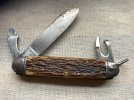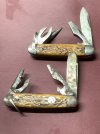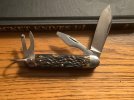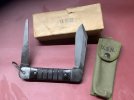I may not use carbon steel as often these days, but I still love to collect vintage Camillus scout knives, and the WW2-era “Engineers Knives” in particular. There’s just something about these knives that I can’t give up. Maybe it’s the fact that I’m fascinated by the scout pattern. It’s possibly because of the wonderful aged bone that one finds on these models. Perhaps it’s due to the incredible fit of these knives; far surpassing most modern scouts. These were mass produced war knives, made by some of the world’s finest cutlers, a dying breed at that time.

My newest acquisition is the ‘Bureau of Medicine and Surgery, Jackknife “Boy Scout” type’. It’s very similar to the plethora of other scout knives issued to US troops during World War 2, but with a different shaped shield that is stamped M.D.-U.S.N., which stands for Medical Department - United States Navy. The specs for this knife are quite interesting in that they specify a range of hardness for all blades, at 56 to 61RC, harder than many traditionals made today, as well as a specific carbon content. The Navy also requested that the pivot pins and shackle on this knife be made of nickel/silver, although I don’t see any evidence that this spec was ever followed. So other than the shield, this knife is pretty much identical to all of the other engineers knives that follow the U.S. Army Engineers 17-170 specification and the Navy 41-J specification. For those interested in seeing some of the original war time documentation on this knife,
a PDF is available from the Collectors-of-Camillus website. Just scroll down to page 14.
This particular knife has seen some hard use, but still has a lot of life left in it. All blades have superb walk and talk, with no wobble. The bone has no cracks. The can opener is in fine condition, as is the cap lifter/screwdriver. The awl needs just a tiny bit of firework to bring the tip back to a point. The main blade has lost just a small amount of the tip, and has been ground down accordingly. I did have to file down the kick to get the new point down below the bolsters. And a very small chip had be sharpened out of the edge. But overall, the knife is still perfectly functional.
Here are a few pictures of my Camillus engineers knife collection thus far. I have a few duplicates, but here is the 'M.D. - U.S.N.' knife issued to Navy Corpsmen, 'U.S.A.' knife issued to the Army, the blank shield issued to the Bureau of Aeronautics, and the version with no shield for Army quartermaster contracts and sold at PX's. There are still a number of other versions for me to find as well, such as the U.S.M.C. knife and the 3-blade U.S.N. model, that I'll try to pick up some day when funds allow.



















